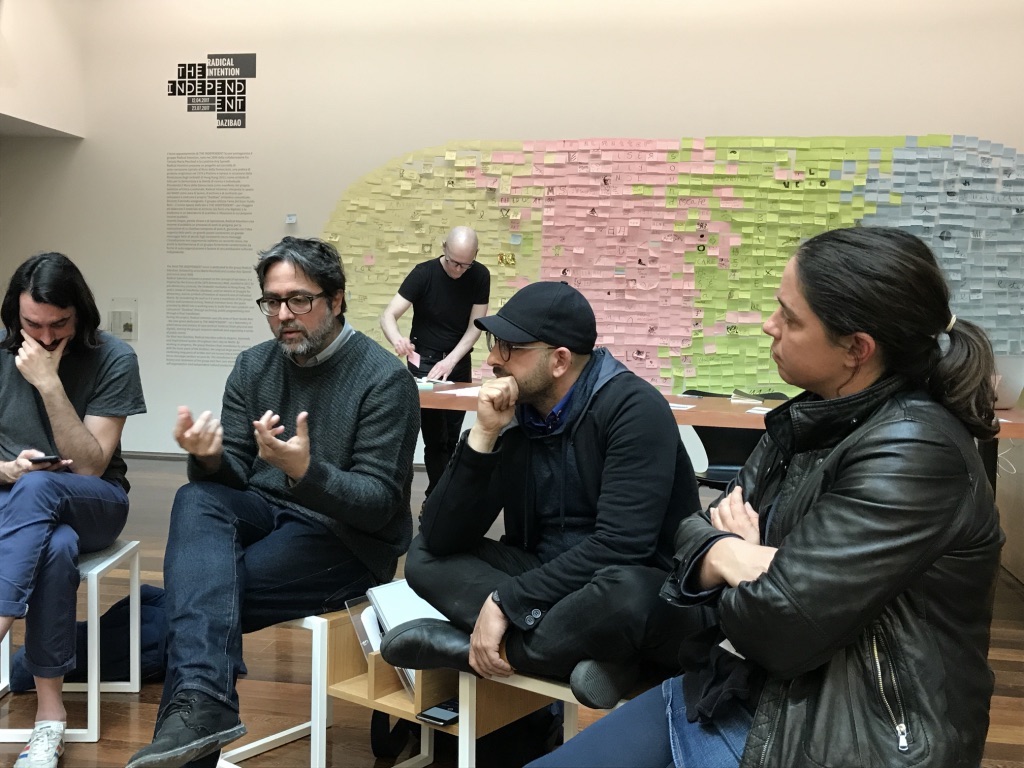
Interview with Emanuele De Donno
Radical Intention
Which strategies ensure a project’s autonomy when matching funding bodies and sponsor’s requests? Did you find yourself mediating between your project’s autonomy and producers or client’s needs?
Rather than strategies, in the cultural and publishing sector I prefer to speak of apparels and approaches, which indicate funding bodies as partners, rather than sponsors. We developed a work ethic around this method that considers clients as co-responsable partners for the production. Part of the mediation process is therefore resolved, and negotiating becomes a search of a middle ground between participation and a natural “conflict” to safeguard our autonomy. Thus the project’s crisis and the “exchanges” between parties is not to be hidden.
What are the project and conceptual consistency principles underlying your interdisciplinary practice? Can you see both strengths and weaknesses of it?
Intermediality and interdisciplinarity enable the use of open, permeable and generous languages and devices. Our project’s scopes are therefore complex, but also open to unknown ramifications and responsive to their the context (a ecology rooted in an ‘open’ and site specific artistic project). Interconnectivity is a sort of analogue device, it is a question of human resources, for which we choose those with “intermediate” qualities, who have both a ‘lack’ of and a ‘high’ expertise.
Consistency is the result of this mediation logic and it constitutes a platform, or rather a neutral and provisional base-work able to host different ideas, participants, and those who inhabit this participated and collective space. The weakness of this “social sculpture” lies in the ambiguous and “violent” concept of participation, which is often politically instrumentalized. It is the critical, controversial node of the building process of any democracy and operational community.
Which are your shared strategies with the Dutch agency Idea Books for the distribution of the self-produced editions? How would you describe self-production and distribution in Italy today?
The concept of distribution is innate in the idea of a book, the content of which is to be “readable and spreadable”. We usually discuss all our publications before publishing with our (dutch) partner, in order to define and sign a pre-agreement.
The end result is a so-called pre-purchase agreement, which leads to the final publication, as it enables its distribution in international museums and independent bookshops.
There are many “self-productions”, but they are often “self-referential” and badly distributed. Sometimes they rely on publicly funded “co-productions” that, especially in Italy, limit the scope of “institutional” books. The latest consolidated phenomenon that has made the circulation of these goods more dynamic is the network of independent and creative publishing festivals, namely an interesting kind of “compensatory” distribution within the Italian territory for independent sub-publishing and artistic-cultural research.
Your publication, Sportification Eurovision Performativity and Playground volume, reveals an aptitude for surreal games mediated by Dadaistic and situationist concepts, which seemingly entertained and shaped the imagination of an entire community. Do you believe that these displays have contributed to defining and building the spirit and imaginary of the European community? Do you believe that games and fantasy can consolidate the unity of a group or a community? What has been lost as far as this practice is concerned, and what can be retrieved?
“Sportification” has advanced hand in hand with the “great European community”. We coined this word to describe a field of critical research that could enshrine the consumption levels of the mediatic agonistic public space and especially of political imagery. The “Games without Frontiers” archive we used for this book, enabled us to implement this critical theory by starting from a collection of “light” images, thereby filtering this “negative discourse” with the idea of television shows, ludic competitions and the artistic imagery.
Indeed, owing to their artistic nature those images come to life. The retrieval of “living” material from the archive is a in depth study of the use of a performative reactivation of the art-game-sport relation in a “non-colonised” public space, and it pushes certain instances of the “democratic game” to the background. The central theme is the playground, rather not a choice for a monolithic European “agonistic” community, but for a collection of meets-pitches, urban adventures, ludic situations typical of various districts and cities. Thanks to this mircorcommunity logic we enabled and recovered the understanding of games as a form of utopia.
Biography
Architect Emanuele De Donno is the founder of VIAINDUSTRIAE collective, an association established in 2005 to promote artistic research and innovative design projects. He conceived and created “Manufatto In Situ” to promote cooperative and co-generative operations at the crossroads between architectural-landscape interventions and artistic-curatorial works. His field of architectural intervention, which falls into the category of critical design, builds upon a theoretical basis that gives rise to a critical project involving social and urban space.
His landscape interventions have seen him cooperate with artists and architects such as Hidetoshi Nagasawa, Tania Bruguera, A Constructed World and Raqs Media Collective. Within the framework of habitats, 2008 he launched a series of practical libraries (in collaboration with Mael Veisse) that were implemented during a series of exhibitions on artists’ book, thereby defining a “platform design” cooperative approach called InbookOTbookIFbook able to involve other planners by use of interdisciplinary starting points such as literature and architecture. This kind of modular design programme stems from research on the various protocols involving books (opening, consultation, reading, exposition). Building upon a display proposed in 2012 for the exhibition “The practical function of 12 networked publications with 4 books, 2 posters and 1 chart” is a catalogue and a collaborative design programme involving book artists, designers and architects.


